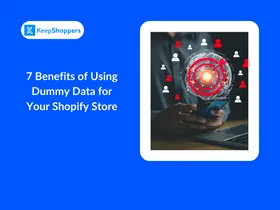Inventory Accounting for Ecommerce Stores: A Quick Guide
Updated February 10, 2023

AI Summary
In today's economy, inventory has turned into one of the most-watched pieces of economic data.
As the fourth-quarter and first-quarter gross domestic product (GDP) reports highlighted, inventory can grow or hurt an economy. It was a key factor in the October-to-December growth, while a significant contributor to the contraction in the January-to-March span.
Inventory accounting has always been a crucial component of running a company. However, under current economic conditions, it is an imperative indicator for the broader market.
But what is it?
Inventory accounting is essentially valuing the company's stocks in its financial records, from the products that the business purchases to how much it costs the entity to manage. Put simply, this is the monetary value of your unsold stockpiles.
How Inventory Accounting Works
Every company specializing in manufacturing, wholesale, and retail must utilize an inventory accounting process whenever it manages inventory. This is critical since this process will value the private firm's inventory assets.
It works by figuring out the cost of goods sold (COGS) during a specified period minus the value of your ending inventory. It is the difference between beginning inventory and ending inventory. Moreover, there are three main components in inventory accounting:
- Raw goods
- In-progress goods
- Finished goods prepared for sale
What is important to note is that the value of current inventory will possess different prices the longer stocks stay in the backroom or storage facility. Business experts recommend that companies should establish an inventory cost method and stick to it moving forward. It should only be adjusted when absolutely necessary, such as when the company expands or inventories grow.
In addition, there are several variables to consider when setting prices, insuring your supplies, and maintaining better control of your inventories, including:
- Value of goods
- Selling price
- Revenues, profits, or losses
- Sales patterns
- Associated costs (storage, shipping, and losses)
Is Inventory Accounting Necessary for Ecommerce Dropshippers?
Many emerging ecommerce entrepreneurs are leveraging platforms like Shopify and WooCommerce to sell their branded items without ever having to worry about warehousing and fulfillment—ie., dropshipping. Since dropshippers don't have to keep their own inventory, it stands to reason that there are several things they won't need to account for. When you utilize a marketplace like Amazon or Etsy, you trust that they will have your listings in stock and not require inventory accounting, but such is not the case.
While it might be up to the suppliers to manage their own inventory accounting, it's up to you to make sure that the products you listed remain in stock with the suppliers and that the suppliers are still listed on the marketplace. As such, inventory accounting is just as essential for Shopify dropshippers as it is for ecommerce merchants who manufacture the goods they sell as you'll need to check the status of your suppliers regularly.
Benefits of Inventory Accounting for Ecommerce Store Owners
In the end, what are the benefits of inventory accounting anyway? Is there an incentive for participating in this process beyond organization?
Yes, there are many advantages to incorporating inventory accounting into your business affairs, such as the following:
- Storage costs Storing inventory can be costly, particularly in today's inflationary environment. Therefore, inventory accounting can help you determine what items are slow to sell, making sure that you will order smaller quantities of these products.
- Bulk discounts Some items in your company sell like hot cakes and will need larger average orders, giving you a lower cost per unit.
- Cash flow As you monitor and track your stock levels, you will ensure that you are not spending too much money on superfluous supplies.
- Sales In this current economy, where too many items are out of stock at many retailers, companies are losing out on potential sales. With proper inventory management, you can reduce this risk.
- Marketing Believe it or not, inventory accounting can also lead to better marketing campaigns since you know what is flying off the shelves during specific times of the year, which can help you construct impressive advertising projects.
Types of Inventory Accounting
Now, there are different types of inventory accounting or inventory valuation methods to improve the process:
First In, First Out (FIFO)
The first finished goods are the first to be sold. When you complete a transaction, the sold item will be deducted from the first list of products that set foot in your establishment.
FIFO can pad your bottom line but also lead to higher taxes.
Last In, First Out (LIFO)
This is the opposite of FIFO: The last products that enter your storage will be the first items to leave.
LIFO will enhance the cost of goods sold, but might not serve as a key indicator of the genuine flow of goods.
Weighted Average Cost (WAC)
By using the WAC accounting method, you can determine the product's average cost throughout the fiscal year. The formula is simple:
Average cost per unit = (total cost) / (total number of units bought during the year)
WAC is easy to determine when prices are stable, but it is volatile when prices fluctuate.
Knowing which tactic to use will depend on your business purposes.
For example, if you are searching for additional capital funding to grow your business, you should employ the FIFO inventory valuation method because your closing inventory will have a greater value. Or, if you looking to save on your end-of-year tax bill, you can take advantage of the LIFO mechanism that can help trim your tax liability.
Furthermore, the entire process of inventory accounting can be simplified with the right accounting software.





